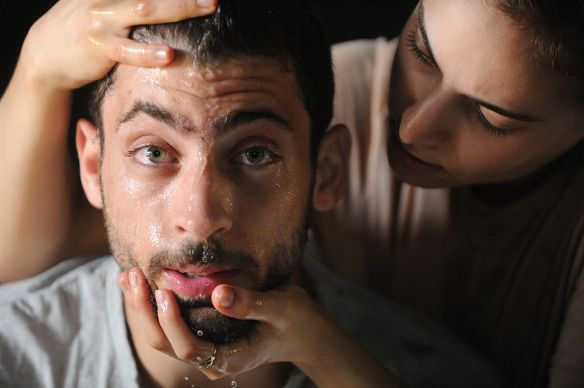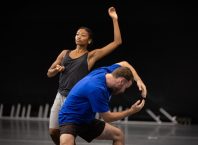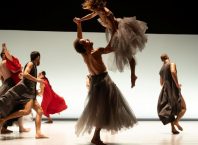A choreography competition for emerging choreographers, Gvanim BeMahol (Shades of Dance) is a bit like speed-dating: getting to know several choreographers at once. I don’t expect to fall in love, but I’m not ruling out the possibility.
This year six choreographers were selected by artistic director Idit Herman, presenting short dance pieces in two programs. It’s an introduction, and although it is officially a competition, that is not where I place my emphasis. I watch the performances not with a critical eye, but with a an open mind (yes, this is where Gvanim diverges from speed-dating). Seeing the work of emerging creative artists, my expectations are explicitly not the same as when viewing the work of those more experienced. The relevant question regarding the work before me onstage at any given moment is: does it make me curious to see more work by this choreographer?
Being a generally curious person, I’ll probably be interested in seeing future works by all six of these choreographers, but there are two who stood out for me: Adi Boutrous and Smadar Goshen.

Smadar Goshen’s Heavy Weight Fragments of Separation (Pirurei Predot BeMishkal Kaved) works with the theatrical narrative frame of television talk shows and pop psychology exorcism. Composing rituals of parting for landmark life experiences – the end of childhood, break-up of a relationship, death and loss of sanity – with texts inspired by Yoel Hoffman’s book Moods, Goshen’s creative humor is evident in every aspect of this work.
Matar Pershitz was the amiable host, welcoming and implicating the audience in his greeting: “We’re all here for the same reason, the traumas of separation we’ve accumulated in our lives.” Designed with tongue-in-cheek flair, the set featured a desk equipped with three paper bags (should anyone feel faint), and the stage space was symbolically divided into the areas affected by and responding to these traumas: brain – a spot light above the stage, heart – the larger, central area of the stage, and the subconscious – a side strip of stage, semi-hidden by a kind of rope curtain. I just can’t rave enough about the costumes, designed by Studio 6B – Irena Bernstein, Hani Mishor, and Andrei Hobla. They were as funny as they were beautiful – I want one!
In this work, Goshen found that delicate balance between the familiar and the bizarre, provoking laughter and rueful recognition. In parting from childhood, Goshen makes use of a song that is firmly embedded deep in the subconscious of many who grew up in Israel (or at least those of a certain age): Yitzhak Katznelson’s Hamesh Shanim al Michael (lyrics: Yitzhak Katznelson; performed by Miki Kam) that describes the rite of passage every child knows: the beginning of one’s schooldays. The song is accompanied by illustrative movements, again hilariously familiar, in the infamous manner of school plays and pageants. Together with a strong cast – Almog Loven, Moran Muller, Adar Riklis and the afor-mentioned Pershitz, Goshen maps out the breaking points in life with acuity and tenderness, dancing on that invisible line between laughter and tears.

Adi Boutrous’ What Really Makes Me Mad (Ma She Be’emet Margiz Oti) follows a very different trajectory, taking the raw material of reality and transforming it into an abstract and poetic dance. Boutrous brings the biographical onstage: as an Arab Christian in a relationship with a Jewish woman, he not only explores their relationship issues, he created and performed the work together with his partner Stav Struz. The confessional mode is a treacherous genre, yet this work resists the temptations of the obvious and volatile, eschewing sentiment, platitudes and poster slogans, transcending the personal to express something essential.
Boutrous and Struz conveyed the contradictory feelings, conflicts, confusion and power struggles within the relationship with images and movement in a work that resonated with youthful vivacity, emotional intensity and beauty. There is a simplicity in this work that I found very powerful. The stage was bare, with a baptismal font set on one side, at the front of the stage. While the religious significance may not be apparent to all viewers, the way that this element was incorporated into the work imbued it with meaning, regardless of one’s cultural or religious background. The relationship of music and silence (with original music by Boutrous), movement, stillness and at times, what felt like the inability to move, all contributed subtle layers of meaning to the complex portrait of a relationship.
Gvanim BeMahol 2013 choreographers: Nitsan Margaliot, Adi Paz, Omer Uziel, Smadar Goshen, Adi Boutrous, Merav Dagan. The judges awarded the first place prize of 18,000 NIS jointly to choreographers Adi Boutrous and Merav Dagan. The competition took place at the Suzanne Dellal Centre from August 29 – 31, 2013, under the artistic direction of Idit Herman. This year’s panel of judges: Leora Bing-Heidecker, Naomi Perlov, Mate Moray, Liat Weisbrot, and Ran Brown.





